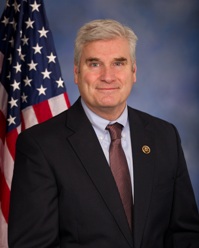Tom Emmer Records Weakest Minnesota GOP US House Primary Win in 50+ Years
No incumbent Minnesota Republican U.S. House member had won less than 80 percent of the primary vote since 1962

Emmer, who has taken heat from some in the Tea Party quarters for his more moderated tone and stances on policy issues after becoming an officeholder in D.C., saw more than 30 percent of primary-voting Republican constituents vote against him on Tuesday as he tallied just 68.7 percent of the GOP vote.
By comparison, DFLers Betty McCollum and Keith Ellison won north of 90 percent with McCollum recording the largest percentage in a contested primary in more than 50 years with her 94 percent showing against frequent candidate Steve Carlson. Four other delegation members did not even draw a primary challenger this cycle (Republican Erik Paulsen and DFLers Tim Walz, Collin Peterson, and Rick Nolan).
Emmer faced two opponents in his primary – most notably A.J. Kern, a business owner and former Benton County Planning Commissioner.
Kern attacked Emmer on a variety of issues including TPP, education, illegal immigration, and for creating the Somalia caucus with Ellison.
In the end, despite Emmer outraising her campaign by more than a 61:1 ratio, Kern received 26.5 percent of the vote with Patrick Munro in a distant third with 4.9 percent.
As a result, Emmer’s 68.7 percent is the lowest support for a Minnesota Republican U.S. Representative recorded in a primary in more than 50 years.
The only incumbent Republican to fare worse than Emmer in a primary since the Gopher State lost a seat due to reapportionment in 1962 was 12-term Congressman H. Carl Andersen.
In 1962, Andersen was redistricted from the 7th CD to the 6th CD and was challenged by former state legislator Bob Odegard.
Odegard crushed Andersen by 27.4 points with the GOP lawmaker carrying only five of the district’s 19 counties (Kandiyohi, Lincoln, Redwood, Renville, and Stevens).
Ever since, the vast majority of Republican U.S. House members did not even draw a primary opponent (66 of 78 from 1964 to 2014) with the remaining dozen who did all eclipsing the 80 percent mark:
- 1970 (7th CD): Odin Langen (93.9 percent)
- 1972 (3rd CD): Bill Frenzel (93.1 percent)
- 1980 (3rd CD): Bill Frenzel (91.4 percent)
- 1982 (1st CD): Tom Hagedorn (87.5 percent)
- 1982 (2nd CD): Vin Weber (88.4 percent)
- 1984 (3rd CD): Bill Frenzel (89.6 percent)
- 2004 (3rd CD): Jim Ramstad (89.9 percent)
- 2006 (1st CD): Gil Gutknecht (87.3 percent)
- 2008 (6th CD): Michele Bachmann (85.9 percent)
- 2012 (2nd CD): John Kline (85.1 percent)
- 2012 (3rd CD): Erik Paulsen (90.2 percent)
- 2012 (6th CD): Michele Bachmann (80.4 percent)
Bachmann (2012) and Emmer (2016) are the only Republicans to draw more than one primary opponent since Joseph O’Hara in 1956’s 6th CD nominating contest.
Since the end of World War II, only Emmer (68.7 percent), Anderson (36.3 percent in 1962), O’Hara (51.3 percent in 1948 and 55.7 percent in 1952), and Harold Knutson (60.0 percent in 1946) failed to win at least 69 percent of the GOP primary vote.
Looking at both DFL and GOP lawmakers, Emmer’s primary tally on Tuesday is the fifth lowest out of 49 contested primaries since 1964. The only members of Minnesota’s U.S. House delegation to receive less support than Emmer were:
- 1980 (8th CD): DFLer Jim Oberstar (55.7 percent)
- 1984 (8th CD): DFLer Jim Oberstar (65.1 percent)
- 1992 (5th CD): DFLer Martin Sabo (67.4 percent)
- 1992 (6th CD): DFLer Gerry Sikorski (49.3 percent)
As for Representative McCollum, her 94.0 percent is the highest mark reached by a Gopher State U.S. House member in a contested primary since Republican Walter Judd won 97.6 percent in the 5th CD nomination race in 1962.
Follow Smart Politics on Twitter.

Thanks for the informative report — as always — Dr. Ostermeier.